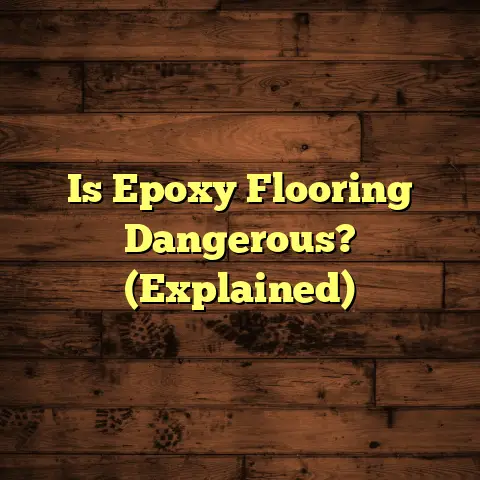How Do You Clean Epoxy Floor? (4 Secrets Inside!)
Let’s bust a myth right off the bat: “Epoxy floors are completely maintenance-free and never need cleaning.”
I can’t tell you how many times I’ve heard that one!
It’s a dangerous misconception that can lead to some serious problems down the road.
Trust me, as a flooring contractor who’s seen it all, neglecting your epoxy floor is a recipe for disaster.
You might think you’re saving time and effort, but you’re actually setting yourself up for costly repairs and a dull, lifeless floor.
So, what’s the real deal with keeping epoxy floors clean?
Well, that’s exactly what I’m going to share with you today.
I’m going to let you in on some secrets that will not only keep your epoxy floors looking pristine but also extend their lifespan.
Ready to dive in?
Section 1: Understanding Epoxy Flooring
Okay, let’s start with the basics. What exactly is epoxy flooring?
Basically, it’s a flooring system made up of multiple layers of epoxy resin that are applied over a concrete substrate.
This resin is mixed with a hardener, creating a chemical reaction that results in a durable, seamless, and incredibly strong surface.
Now, you might be wondering where you typically find epoxy flooring.
Well, it’s incredibly versatile, so you’ll see it in both residential and commercial settings.
Think garages, basements, workshops, commercial kitchens, hospitals, showrooms and even airplane hangars!
The reason for its popularity lies in its many benefits.
-
Durability: Epoxy floors can withstand heavy foot traffic, impacts, and even chemical spills.
-
Aesthetic Appeal: They come in a wide array of colors, patterns, and finishes, allowing for endless design possibilities.
-
Resistance to Stains and Spills: Epoxy is non-porous, meaning liquids and stains can’t penetrate the surface.
I remember one client who had a serious oil leak in his garage.
He was convinced his concrete floor was ruined.
But after I installed an epoxy floor, he never had to worry about oil stains again!
Section 2: The Importance of Regular Cleaning
Alright, now that you know what epoxy flooring is, let’s talk about why cleaning it regularly is so crucial.
I know, I know, cleaning isn’t exactly anyone’s favorite activity, but trust me, it’s an investment in the long-term health and beauty of your floor.
Think of it like this: you wouldn’t neglect to change the oil in your car, right?
Regular cleaning is the “oil change” for your epoxy floor.
So, what happens if you neglect proper cleaning?
Well, a few things can occur:
-
Potential Damage: Dirt, grime, and debris can scratch and dull the surface of the epoxy over time.
-
Dullness: Without regular cleaning, your floor will lose its shine and luster.
-
Stains: Spills that are left unattended can seep into the epoxy and become incredibly difficult to remove.
I’ve seen floors that have been neglected for years, and let me tell you, it’s not a pretty sight.
The good news is that with a little bit of routine maintenance, you can keep your epoxy floor looking fantastic for years to come.
Routine maintenance is really about establishing a cleaning schedule and sticking to it.
It’s about being proactive rather than reactive.
Section 3: Secret #1 – The Right Tools and Materials
Okay, let’s get down to the nitty-gritty.
What do you need to actually clean your epoxy floor effectively?
Having the right tools and materials is half the battle.
Trying to clean an epoxy floor with the wrong equipment is like trying to paint a house with a toothbrush – it’s just not going to work!
Here’s a list of my recommended tools:
-
Soft Broom: For sweeping up loose debris.
-
Microfiber Mop: For applying cleaning solutions and rinsing.
-
Microfiber Cloths: For wiping up spills and spot cleaning.
-
Two Buckets: One for the cleaning solution and one for rinsing.
Now, let’s talk about cleaning solutions.
The key here is to be gentle.
Epoxy is durable, but it can be damaged by harsh chemicals.
I always recommend using pH-neutral cleaners.
These cleaners are specifically designed to be gentle on epoxy surfaces while still being effective at removing dirt and grime.
You can find pH-neutral cleaners at most hardware stores or online retailers.
Here are a few DIY options you can try:
-
Dish Soap and Water: A classic combination that works wonders on most epoxy floors. Just be sure to use a mild dish soap.
-
Vinegar and Water: Mix one cup of white vinegar with a gallon of water for a natural and effective cleaner.
Important: Always test any cleaning solution in an inconspicuous area first to make sure it doesn’t damage the epoxy.
What should you avoid using?
-
Abrasive Cleaners: These can scratch and dull the surface of the epoxy.
-
Acidic Cleaners: These can damage the epoxy and cause it to lose its shine.
-
Bleach: Bleach can discolor and damage epoxy floors.
-
Steel Wool or Scrub Brushes: These can scratch the epoxy surface.
I once had a client who tried to clean his epoxy floor with a scouring pad.
Let’s just say it didn’t end well.
He ended up with a scratched and dull floor that needed to be professionally repaired.
Section 4: Secret #2 – The Correct Cleaning Technique
Now that you have the right tools and materials, let’s talk about how to actually clean your epoxy floor.
Follow these steps for a sparkling clean floor:
-
Remove Loose Debris: Use a soft broom or vacuum to sweep up any loose dirt, dust, or debris.
I recommend using a vacuum with a soft brush attachment to avoid scratching the floor.
-
Prepare the Cleaning Solution: Mix your chosen cleaning solution according to the manufacturer’s instructions or the DIY recipe.
Make sure to use warm water, as it helps to dissolve dirt and grime more effectively.
-
Mop the Floor: Dip your microfiber mop into the cleaning solution and wring it out so it’s damp, not soaking wet.
Mop the floor in overlapping strokes, focusing on high-traffic areas and any areas with visible dirt or stains.
-
Rinse the Floor: Empty the dirty water from your cleaning bucket and fill it with clean, cool water.
Rinse the mop and wring it out again. Mop the floor with clean water to remove any cleaning solution residue.
-
Dry the Floor (Optional): If you want to speed up the drying process, you can use a clean, dry microfiber cloth to dry the floor.
This will also help to prevent water spots.
Dealing with Tough Stains
What about those stubborn stains that just won’t budge?
Here are a few tips for dealing with tough stains:
-
Oil Spills: Absorb the oil with a paper towel or cloth as soon as possible.
Then, sprinkle baking soda over the stain and let it sit for a few hours.
Vacuum up the baking soda and clean the area with a pH-neutral cleaner.
-
Chemical Spills: Clean up chemical spills immediately with a pH-neutral cleaner.
Be sure to wear gloves and eye protection when handling chemicals.
-
Dried Paint: Scrape off as much of the dried paint as possible with a plastic scraper.
Then, soak a cloth in warm water and dish soap and apply it to the remaining paint.
Let it sit for a few minutes, then scrub gently with a soft brush.
I had a client who accidentally spilled a can of paint on her epoxy floor.
She was panicked, but I assured her that it could be cleaned up.
We followed the steps above, and you’d never know there had been a paint spill!
Section 5: Secret #3 – Frequency of Cleaning
So, how often should you be cleaning your epoxy floor?
The answer depends on a few factors, including how much foot traffic the floor gets and what kind of activities take place on it.
Here’s a general cleaning schedule to follow:
-
Daily: Sweep or vacuum the floor to remove loose debris.
-
Weekly: Mop the floor with a pH-neutral cleaner.
-
Monthly: Deep clean the floor with a more concentrated cleaning solution.
You can also use a floor buffer to restore the shine.
-
Seasonally: Give your epoxy floor a thorough deep cleaning, paying attention to any areas that may have accumulated dirt or grime over time.
This is also a good time to inspect the floor for any damage and make any necessary repairs.
If you have a high-traffic area, like a garage or commercial kitchen, you may need to clean it more frequently.
I always tell my clients to use their best judgment.
If the floor looks dirty, it’s time to clean it!
Section 6: Secret #4 – Preventative Measures
The best way to keep your epoxy floor looking great is to prevent it from getting dirty in the first place.
Here are a few preventative measures you can take:
-
Use Mats in Entryways: Place mats at all entrances to trap dirt and debris before they can get onto the epoxy floor.
-
Place Protective Pads Under Furniture: This will prevent scratches and scuffs from furniture legs.
-
Clean Up Spills Immediately: The longer a spill sits, the harder it will be to remove.
-
Avoid Dragging Heavy Objects: If you need to move heavy objects across the floor, use a dolly or furniture sliders.
-
Consider a Top Coat: Applying a top coat of polyurethane or acrylic sealant can provide an extra layer of protection against scratches and stains.
I always recommend using mats in entryways.
They’re a simple and inexpensive way to keep your epoxy floor clean.
Maintaining the Glossy Finish
Want to keep your epoxy floor looking shiny and new?
Here are a few tips:
-
Periodic Buffing: Use a floor buffer with a polishing pad to restore the shine to your epoxy floor.
-
Re-Sealing: Apply a new coat of epoxy sealant every few years to protect the floor and maintain its glossy finish.
I had a client who was worried that her epoxy floor was starting to look dull.
I recommended buffing it with a floor buffer, and she was amazed at how much it improved the appearance of the floor.
Conclusion
So, there you have it: the four secrets to cleaning your epoxy floor like a pro!
Remember, regular cleaning and maintenance are essential for keeping your epoxy floor looking pristine and extending its lifespan.
By following these tips, you can enjoy your beautiful and durable epoxy floor for years to come.
Don’t forget to:
-
Use the right tools and materials.
-
Follow the correct cleaning technique.
-
Clean your floor regularly.
-
Take preventative measures.
Now, I want to hear from you!
Do you have any tips or experiences with epoxy floor cleaning that you’d like to share?
Leave a comment below!
Let’s keep the conversation going and help each other keep our epoxy floors looking their best.





